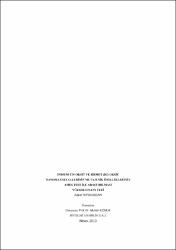| dc.contributor.advisor | Konuk,Muhsin | |
| dc.contributor.author | Tepekozcan, Aykut | |
| dc.date.accessioned | 2019-05-21T08:44:59Z | |
| dc.date.available | 2019-05-21T08:44:59Z | |
| dc.date.issued | 2013 | |
| dc.identifier.uri | http://hdl.handle.net/11630/5952 | |
| dc.description | In this study, the mutagenic effects of Indium tin oxide and Bismuth oxide nanomaterials, commonly used in many fields of industry, have been investigated by using short-term bacterial mutagenicity test system namely Salmonella/microsome. In the Salmonella/microsome test system the mutant strains were used Salmonella typhimurium TA 98 and TA 100. These strains were tested both in the presence and absence of metabolic activation that contain microsomal enzymes. While 625 g/plate, 1250 g/ plate, 2500 g/ plate, 5000 g/ plate and 10000 g/ plate label concentrations were tested for Bismuth oxide nanometerials, 12.5 g/ plate, 25 g/ plate, 50 g/ plate, 75 g/ plate, 100 g/ plate, 125 g/ plate and 150 g/ plate concentrations were tested independently in parallel experiment for Indium tin oxide nanomaterials. At the absence of S9, 4-nitro-o-fenilendiamine, at the presence of S9, 2-aminofluorene was used as a positive control for TA 98. At the absence of S9, Sodium azid, and the presence of S9, 2-aminoanthracene was used as a positive control for TA 100. Water solution were used as a negative control. Results of experiments were compared with positive and negative control groups data. Consequently; mutagenic effects were not observed both Indium tin oxide and Bismuth (III) oxide in two strains. | en_US |
| dc.description.abstract | Bu çalışmada, sanayinin birçok alanında sıkça kullanılan 2 farklı ( İndium tin oksit ve Bizmut (III) oksit) nanomateryalin mutajenik etkileri, kısa zamanlı bakteriyel mutajenite test sistemlerinden olan Salmonella/mikrozom test sistemi ile araştırılmıştır. Çalışmada Salmonella typhimurium’un iki suşu olan TA98 ve TA100 suşları kullanılmıştır. Bunun için her iki suş mikrozomal enzimler içeren metabolik aktivasyon (S9) varlığında ve yokluğunda, Bizmut (III) oksit nanomateryalinin 625 g/plak, 1250 g/plak, 2500 g/plak, 5000 g/plak ve 10000 g/plak konsantrasyonları, İndium tin oksit nanomateryali için ise 12.5 g/plak, 25 g/plak, 50 g/plak, 75 g/plak, 100 g/plak, 125 g/plak ve 150 g/plak konsantrasyonlarında iki bağımsız paralel deneyde test edilmiştir. S9 yokluğunda pozitif kontrol olarak TA98 için 4-nitro-o-fenilendiamin, S9 varlığında ise 2-aminofluoren, TA100 için ise S9 yokluğunda sodyum azid ve varlığında ise 2-aminoantrasen kullanılmıştır. Negatif kontrol olarak ise distile su kullanılmıştır. Test sonuçları iki deneyin ortalaması alınarak değerlendirilmiş, pozitif ve negatif kontrol grupları ile karşılaştırılmıştır. Sonuç olarak; İndium tin oksit ve bizmut (III) oksit nanomateryallerinin kullanılan iki suşta da mutajenik etkisine rastlanmamıştır. | en_US |
| dc.language.iso | tur | en_US |
| dc.rights | info:eu-repo/semantics/openAccess | en_US |
| dc.subject | Ames test, mutajenite, Bizmut (III) oksit, İndium tin oksit, nanomateryal | en_US |
| dc.title | İndium Tin Oksit ve Bizmut (Iıı) Oksit Nanomateryallerinin Mutajenik Özelliklerinin Ames Test ile Araştırılması | en_US |
| dc.title.alternative | The Investıgatıon of Mutagenıc Propertıes of Indıum Tın Oxıde and Bısmuth (Iıı) Oxıde Nanomaterıals wıth Ames Test | en_US |
| dc.type | masterThesis | en_US |
| dc.department | Fen Bilimleri Enstitüsü | en_US |
| dc.identifier.startpage | 1 | en_US |
| dc.identifier.endpage | 62 | en_US |
| dc.relation.publicationcategory | Tez | en_US |



















